Rare Rides Icons: The History of Stutz, Stop and Go Fast (Part XVII)

We’re back again with more Stutz history, and our coverage of the bric-a-brac produced by the Stutz Neoclassical company as complementary offerings to two-doors like the Blackhawk, Bearcat, and Bearcat II. In our last entry, we covered the Duplex, a sedan that (unsuccessfully) wore Blackhawk styling. Based either on a Pontiac or a Cadillac, the Duplex was the ultimate production version of the Ministeriale prototype sedan built by Carrozzeria Padane.
With an astronomical ask of $32,500 ($251,312 adj.) circa 1970 and styling that hadn’t translated well into a sedan, the Duplex was a non-starter. Just one was ever made, and it was sold to a criminal in Utah. But that didn’t deter CEO James O’Donnell, who was insistent a Stutz sedan was viable. A few years later there was another Stutz sedan presented: IV-Porte.
Unlike the name of the Duplex, the IV-Porte stated its purpose right on the grille (in gold of course). With its basis in Italian coachbuilding surely Stutz would have preferred Quattroporte, but that name was already in use for the fairly crap third-generation Maserati sedan.
Recall from our past entry that Stutz was faced with Seventies downsizing like other manufacturers. But unlike other OEMs Stutz was more a secondhand manufacturer, forced to rely on platforms from General Motors which it then rebodied. The G-body Grand Prix platform it used for its volume Blackhawk went out of production in 1972. Thus, in the mid-Seventies Stutz was forced to generate new two- and four-door design ideas. They called Paolo Martin.
Martin sketched the IV-Porte’s design in 1976, at the same time he did a rework of the Blackhawk. Martin was well-known for his automotive designs throughout the Seventies and created a portfolio of work during his employment with Pininfarina. When he worked on the new cars for Stutz he looked to the original Exner designs for inspiration. What resulted – like the second version of the Blackhawk – was a four-door (unnamed at the time) on a smaller scale than its predecessor.
From the 1976 sketches, Stutz worked up a new sedan that had AMC-style door handles. The timeline has the four-door’s announcement in either 1977 or 1978, but production didn’t start until later. Initial drawings were labeled with a name that was not ultimately chosen for the car: Diplomatic. Stutz made use of that name later, but before launch, the new sedan was renamed IV-Porte.
Unlike the deceased Duplex, the source material for the IV-Porte was more obvious: The General Motors B-body, in particular the Pontiac Bonneville. Stutz was a fan of the Bonneville at that time and used it for the Blackhawk and the first Bearcat targa. While those two models used the Bonneville two-door sedan, the new IV-Porte was based on the four-door Bonneville. Production of the IV-Porte started in 1979, around the same time as the other two Stutz models.
Given they shared a platform, most of the parts from the new Blackhawk translated right over to the IV-Porte. All the Exner-lite styling was present, from the freestanding lamps to the fenders with their awnings over the driving lamps. Also implemented was the chromed version of the Bonneville’s bumper with its main giveaway, the amber indicators. The IV-Porte used the same engines as the Bonneville, which we’ve covered in a previous entry.
Chrome exterior fixtures and fittings were the same on the IV-Porte as on the Blackhawk. The two shared the same notable trim: the gently curved chrome strip that helped the sedan look as long as possible. The lower chrome door decoration from the Blackhawk was used too but had to be duplicated (and slightly shorter) on the rear door of the sedan. It gave the odd effect of two dashes on either side, supported beneath by the nonfunctional chrome exhaust pipe that exited from the fender.
Stutz kept the doors and windows from the donor Bonneville, but curiously decided to skip the more formal skirted fender it wore from the factory. Speaking of formality, the C-pillar of the Bonneville was far too sloped and just wouldn’t do for IV-Porte duty. Stutz designers edited that into a more brand-friendly shape, with an almost vertical C-pillar that was much thicker. The roof redo gave a more formal look and brought the sedan in line with its coupe brother. Like all Stutz models, it had a shrunken rear window as a result of the thick pillar.
The rear end of the IV-Porte was a copy and paste of the Blackhawk, with its sloped rear fender line, minor fender overhangs highlighted in chrome, and covered spare tire in the middle of the trunk lid. Overall the look was reduced like the new Blackhawk but didn’t look as cobbled as the ill-fated Duplex.
Fortunes improved on the IV-Porte’s interior as well, as it received the same burled wood dash, gold plated fittings, and plush upholstery materials as found on the Blackhawk. The amount of gold on the interior should not be underestimated, as nearly every switch, lever, handle, and button was coated in it. One set of switches escaped the Midas Touch: The power seat controls. Worth noting, not all customers ordered their IV-Porte with full leather. A dark blue example from the marketing and the light blue one shown below have a leather and velour combo interior.
Since the IV-Porte was less custom work and had its basis on a smaller vehicle, one might assume it cost less than the Duplex earlier in the decade. But that assumption would be wrong! In 1981, the IV-Porte asked $84,500 ($287,796 adj.), or nearly 13 percent more than the Duplex. Reportedly, that ask was the same as the contemporary Blackhawk.
However, unlike the Duplex the IV-Porte actually found some buyers. Barry White (1944-2003) added a cream and brown IV-Porte next to the Blackhawk in his garage. White’s example became the focus of an episode of Counting Cars in 2012, as White’s widow asked the show to find and restore the long-lost sedan. The car was successfully located and restored to its former glory (Season 1, Episode 13). Other musical IV-Porte customers included Kenny Rogers (1938-2020), who purchased a white example in 1980.
Production of the IV-Porte continued through 1981, and it’s believed around 50 were made. For its three-year production timeline, the IV-Porte was a very successful offering for Stutz. Perhaps the Duplex was just offered a bit too soon, when the company lacked the brand recognition to ask big money for a sedan. The situation was different a few years later after word got around that the showbiz elite were fans of the new Stutz.
The discontinuation of the IV-Porte was simply a practical matter, as the end of 1981 was the end of the B-body Pontiac Bonneville. The downsizing monster claimed another victim. Stutz had to switch to a new donor model, even if it still used the same B-body platform. Said model changeover gave Stutz a chance to think bigger for its sedan, so starting in 1982 customers would have more room for activities in their four-door Stutz. We’ll pick up with the IV-Porte’s grandiose evolution next time.
[Images: Stutz, YouTube]

Interested in lots of cars and their various historical contexts. Started writing articles for TTAC in late 2016, when my first posts were QOTDs. From there I started a few new series like Rare Rides, Buy/Drive/Burn, Abandoned History, and most recently Rare Rides Icons. Operating from a home base in Cincinnati, Ohio, a relative auto journalist dead zone. Many of my articles are prompted by something I'll see on social media that sparks my interest and causes me to research. Finding articles and information from the early days of the internet and beyond that covers the little details lost to time: trim packages, color and wheel choices, interior fabrics. Beyond those, I'm fascinated by automotive industry experiments, both failures and successes. Lately I've taken an interest in AI, and generating "what if" type images for car models long dead. Reincarnating a modern Toyota Paseo, Lincoln Mark IX, or Isuzu Trooper through a text prompt is fun. Fun to post them on Twitter too, and watch people overreact. To that end, the social media I use most is Twitter, @CoreyLewis86. I also contribute pieces for Forbes Wheels and Forbes Home.
More by Corey Lewis
Latest Car Reviews
Read moreLatest Product Reviews
Read moreRecent Comments
- V8fairy Not scared, but I would be reluctant to put my trust in it. The technology is just not quite there yet
- V8fairy Headlights that switch on/off with the ignition - similar to the requirement that Sweden has- lights must run any time the car is on.Definitely knobs and buttons, touchscreens should only be for navigation and phone mirroring and configuration of non essential items like stereo balance/ fade etc>Bagpipes for following too close.A following distance warning system - I'd be happy to see made mandatory. And bagpipes would be a good choice for this, so hard to put up with!ABS probably should be a mandatory requirementI personally would like to have blind spot monitoring, although should absolutely NOT be mandatory. Is there a blind spot monitoring kit that could be rerofitted to a 1980 Cadillac?
- IBx1 A manual transmission
- Bd2 All these inane posts (often referencing Hyundai, Kia) the past week are by "Anal" who has been using my handle, so just ignore them...
- 3-On-The-Tree I was disappointed that when I bought my 2002 Suzuki GSX1300R that the Europeans put a mandatory speed limiter on it from 197mph down to 186mph for the 2002 year U.S models.



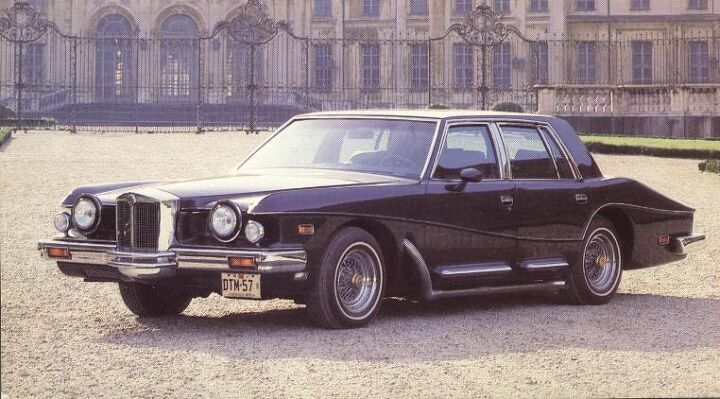























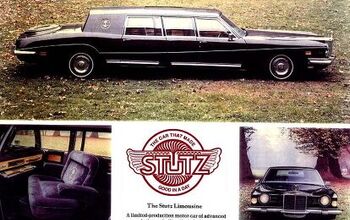

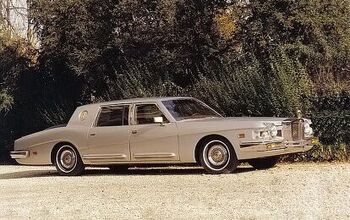
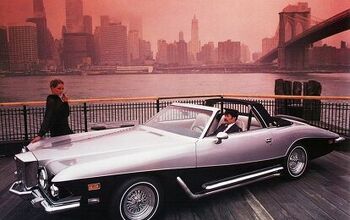
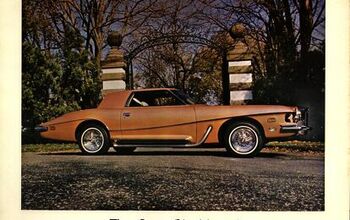










Comments
Join the conversation
The horror, the horror...
Corey...blur the photos!!! My God, that tan/brown "car" up top...whoa. All it needs are "The Duke of NY's" chandeliers riding on the tops of the front fenders to top it off.
I even think Elvis and Liberace would have said "Man, that's too much. Dial it back a bit."
And did the reply buttons not survive the transition to the new format? Or are they staring in front of me and I missed them?